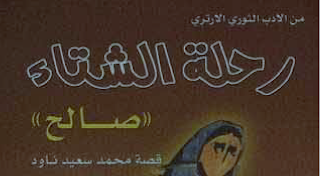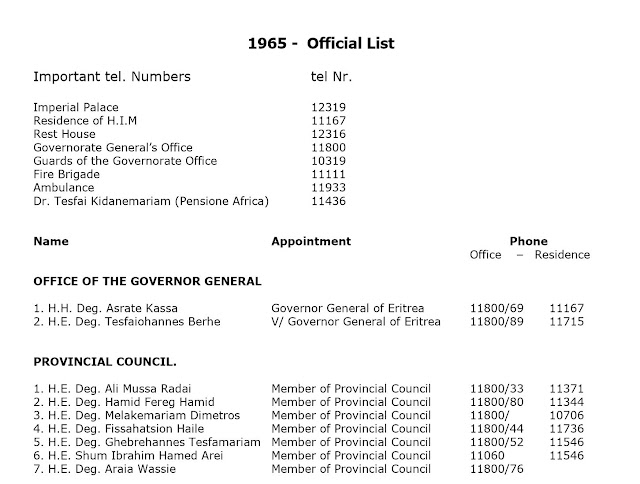Dr. Hashim A-Shami:
On the Afar roots of martyr Abdulgader Mohamed Saleh Kebire
I asked Dr. Hashim Jamal al-Din A-Shami (widely known as Hashim A-Shami
*) about the links of late Eritrean politician, martyr Abdulgader
Kebire to the Afar and he wrote this note hastily in Arabic and below is a translation of
his note, in English. Any mistakes in translation, mine.
"The great and veteran politician,
martyr Abdulgadir Mohamed Saleh Kebire, is of Afar-Jeberti origins and
was born on Dese island, which is part of the Afar region within the
Buri Peninsula. His mother, Fatima Kebir was from the Dahimela tribe. His
brother, Ibrahim, lived and was buried in the Qenfur area, near Dese island.
Kebire married Zeinab Ishaq Adam from the tribe of Sheikh Adamtu (son of
Sheikh Adem). The uncles of his wife are from the tribe of Qaas Sambo. One
of Abdulgadir’s sisters, Aisha Kebri was married to Ibrahim from the tribe of
Kifertu. His second sister, Madina was married to Rashid Abdu from the 'Ante li Sheikh Ali' tribe It should be noted that his mother Fatima and his
sisters, Aisha and Madina died in and were buried in the village of Adai le
Dora Dese Peninsula.
There is no doubt that Mr. Abdulgadir Kebire
also lived in among the Jeberti in Asmara where he practiced his political and daily
life and had children from his Jeberti wife. The influence of the Jeberti
community was very important in the formation of his personality, development
and the special social status he achieved. It is worthy to note that the Afar,
and the Jeberti in general and Argobba (Arab Jebey) had important historical relations
in the Sultanate of IFAT. The Ifat Sultanate was dependent on the Emirate of
Adal which was in part of the Afar region. The center of the Sultanate of IFAT was
in the city of 'Dawe', which is currently part of the Afar region in Ethiopia.
It was the hub and zone of influence of the Emirate of Bodaye. Amir Mohamed
Bodaye had authority over the city of ‘Dawe’ in the 19th and 20th
century and it was the core of his Dahimele tribe.
The jeberti are originally, from the land
of IFAT. According to Ibn Saeed, who lived 1214 – 1287 AD, IFAT was also known
as the land of the Jeberti (Jeberta)
and he stated, “It has a Muslim king and the inhabitants are Muslims from
different ethnic groups and IFAT city lies on higher ground.”
Even the historian, Al-Mughrizi pointed
that the Welashma family that claims to be from Arabian roots from Al-
Hijaz, had settled in the land of al-Jabr (Jeberta).
The great
Italian historian, E. Cerulli,
obtained, during the occupation of Ethiopia by Italy, a document written in Arabic
that clearly indicates that there was a Makhzoumi Sultanate in East of
Shoa established in 283 according to the Hijra calender corresponding to
896/897 AD and it was destroyed due to internal conflicts and in addition to
the invasion of Ali Ibn Waliasma in 1277 AD.
As is well-known to all, Beni Makhzoum
is a very famous Mekka tribe, where the great Muslim military leader, Khalid
Bin Al Waleed belonged to. The Beni Makhzoum were at odds with Beni
Umiah. It is believed that an important part of this tribe migrated to
Abyssinia during the Islamic rule of caliph Omar Bin Al Khattab. Thus, one can
say, in brief, that the Jeberti are of Arab origin who lived in east Shoa, and
especially around the IFAT. As has been stated above the Sultanate of IFAT, had
different ethnic groups within it (Afar, Jeberti and Argobba).
In addition to that, the Jeberti had very
important contributions to safeguard Islam and to raise its status in Gondar, Tigray,
Seraye and Hamassein (Asmara). Due to that, the name Jeberti became
tied to Islam such that the Islamic institution, Al Azhar established centuries ago,
a special gallery (learning unit) for students from Abyssinia, known as the Jeberta
gallery (riwag al jeberta).
The Jeberti, particulary in Seraye and
Asmara were dynamic and active in the commercial, cultural, scientific and
political fields in Eritrea in the period from 1942 to 1952. They played also
big role the preservation and practice of moderate Islam, which believes and
calls for moderation and coexistence among the national components, Muslims and
non-Muslims. The Grand mufti, Sheikh Ibrahim Mokhtar, a graduate of Al Azhar
University, played also a big role in this regard with his reformist directives.
In addition to that, the presence of families and members of the Jeberti
community, such as the families of Aberra,
Hagos, and Khairallah and others played an important role, too. Among
the individuals, to name a few were Berhanu Ahmeddin, the veteran and
courageous politician, as well as the writer and intellectual, Mahmoud Noor
Hussain.
Mahmoud may have been one of the most prominent
intellectuals of his time. He was fluent in Italian, Arabic and English
languages, and his books in Arabic history and language, including translations
of some publications from English and Italian to Arabic and vice versa, was a
great contribution. I thus urge for the works of Mahmoud Nour Hussein be
published. Thus, the Jeberti activity was not limited to trade, as some
components of Eritreans, fond of stereotypes want to portray them. This
reflects their shallow understanding of the Jeberti. Some components do this to
undermine or do injustice to others.
Abdulgadir Kebire was also married to a
Yemeni woman and had children from her. Abdulgadir’s son, Saleh Abdulgadir kebire was an intellectual.
He graduated from the American University in Beirut. He was aware of his Afar
roots and had close and daily contacts with many of the Afar, while he was the
Mayor of Massawa and during his long stay in Addis Ababa, where he practised as
a lawyer and later became the Chair of the Ethiopian Lawyers’ Association. During
his stay in Massawa and Asmara, he was in contact with his relatives in the Buri
Peninsula, especially with his aunt Aisha, who used to visit the family of
Abdulgadir Kebire in Asmara. Saleh Kebire died in March 2000 and was buried in
Addis Ababa.
It is known that the leader Abdulgadir
Kebire was a friend of several Afar dignitaries, including, among others,
Sheikh Yassin Mahamodah Qahmed, Sheikh Musa Qaas Mohamed, Sheikh Jamal al-Din
Ibrahim Khalil al-Shami, Sheikh Siraj Mohamed Kamel, Haj Mohamed Osman Houri
and Sheikh Rashid Ismail Hamid Hassen. Sheikh Siraj Mohamed Kamel was one of the
closest friends of Abdulgadir. When World War II broke out, Abdulgadir sent his
elder son, Saleh, to Dahlak to study with the family of Sheikh Siraj Mohammed
Kamel and under his supervision. Saleh returned to Asmara after the British
occupation and the end of the war.
I would like to reiterate again about the
importance of the Jebrti’s community in Asmara in the formation and development
of the personality of the leader Abdulgadir. There is no doubt that Abdulgadir
had all the characteristics of leadership, knowledge and a solid will. He was
an intellectual who was loyal to his principles.
To sum up what is important is not a
personal affiliation of an individual to a particular tribe or a social
component, but what matters most is a person’s achievement to his country and endeavours
to raise the value of humanity in general and efforts in achieving freedom and
social justice.
On the other hand, it is very important,
but not the most important for me (Hashim Jamal al-Din A-Shami) to answer the
question by Dr. Mohamed Kheir Omer. It is the right of researchers and citizens
to know the background of a public person, particularly about leaders and the
people who left their distinguished marks on a particular region or country. “
Signature
Hashim Jamal al-Din A-Shami
*Hashim Gamaluddin Ibrahim Al-Shami, holds a doctorate degree in Economics from the University of University of Wisconsin - Madison, USA. He is interested in the history and studies of East Africa and Southern Arabian Peninsula. He is a co-author (the other author was his father, Sheikh Gamaluddin Ibrahim Al-Shami) of the book on the History of the Afar, in Arabic that was issued in 1991, and the second edition was published in 1996. The book is in about 750 pages. His father wrote 182 pages of the book. The book was translated to Amharic, with additions to the Arabic version in 2007 with the title (ዓፋር (ደንከል) ታሪክና መረጃ አርክ ምንጭ). The book was recently translated to English.












